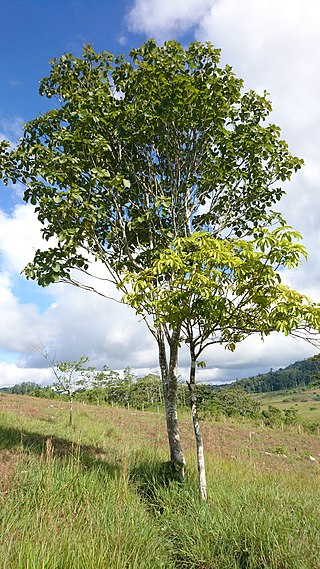
Sebastiania is a genus of flowering plants in the family Euphorbiaceae first described in 1821. It is native to North and South America from Arizona and the West Indies south to Uruguay.

Joosia is a genus of flowering plants in the family Rubiaceae. There are at least 11 species. They are distributed from Costa Rica to Bolivia with the center of diversity in Ecuador.

Simira is a genus of plants in the family Rubiaceae. The genus was first published by French pharmacist and botanist Jean Baptiste Christophore Fusée Aublet in Hist. Pl. Guiane vol.1 on page 170 in 1775.

Chiococca is a genus of flowering plants in the family Rubiaceae. It currently holds 23 species that are native to Florida, Texas, Mexico, Central America, much of South America, the West Indies, and the islands of Galápagos and Fernando de Noronha.

Duroia is a genus of flowering plants in the family Rubiaceae. The genus is found from Costa Rica to tropical South America.

Amphidasya is a genus of flowering plants in the family Rubiaceae. It was described by Paul Carpenter Standley in 1936. The genus is found in Central America and northern South America.
Retiniphyllum is a genus of flowering plants in the family Rubiaceae and contains 20 species. It is the only genus in the tribe Retiniphylleae. The representatives are shrubs or small trees that grow in white sand soils in tropical South America. They are mainly distributed in the Guayana Region (Venezuela) but also occur in the Amazon Basin, the eastern Andes and central and eastern Brasil.

Chomelia is a genus of flowering plants in the family Rubiaceae. It is native to Mexico, Central America, the West Indies, and much of South America as far south as Argentina.

Geophila is a genus of herbs in the family Rubiaceae. This genus is pantropical, as it is found in most tropical regions.

Pentagonia is a genus of over 40 species of plants in the Coffee or Gardenia family (Rubiaceae}. Pentagonia species are native to Central America and northern South America, and grow in moist tropical forests below 900m. The genus was first described by George Bentham in 1845. The genus is noteworthy for its opposite pairs of huge leaves in a variety of shapes including entire, shallowly or deeply lobed, and even pinnate. These leaves can, in the case of a recently discovered species be up to four feet long not including the six inch petiole, and up to 2.5 feet in width.

Carapichea is a genus of flowering plants in the family Rubiaceae. It is native to Central America and northern South America from Nicaragua to Brazil. One species, Carapichea ipecacuanha, is used medicinally as the source of ipecac, a powerful emetic.

Coussarea is a genus of flowering plants in the family Rubiaceae. The genus is found from southern Mexico to tropical America.
Declieuxia is a genus of flowering plants in the family Rubiaceae. The genus is found in tropical America.

Posoqueria is a genus of flowering plants in the family Rubiaceae. The genus is found Mexico to tropical America.

Pagamea is a genus of flowering plants in the family Rubiaceae, native to northern South America. Shrubs or small trees, they are specialists in the Amazonian white-sand forests.
Hippotis is a genus of flowering plants belonging to the family Rubiaceae.

Matayba is a genus of flowering plants belonging to the family Sapindaceae.

Eumachia is a genus of flowering plant in the family Rubiaceae. Its species are native to tropical and subtropical regions worldwide. The genus was established by Augustin Pyramus de Candolle in 1830.















